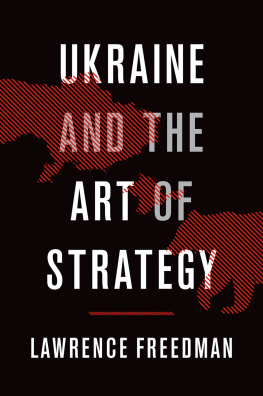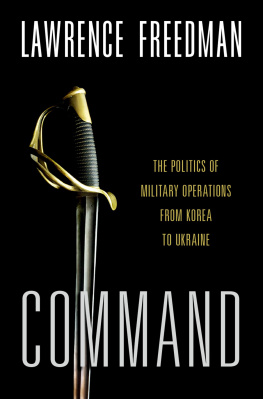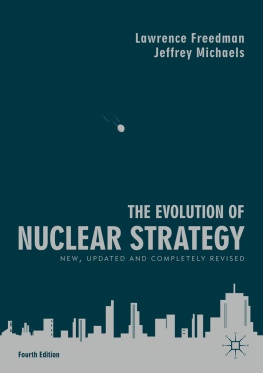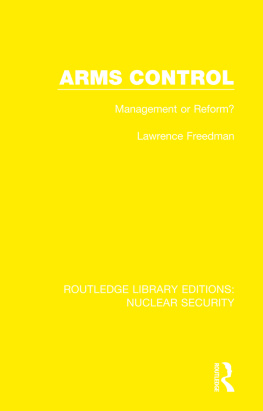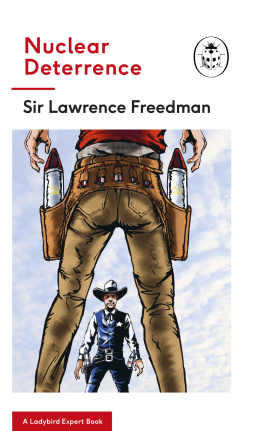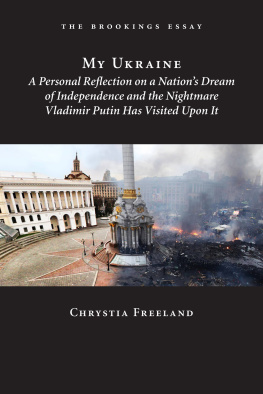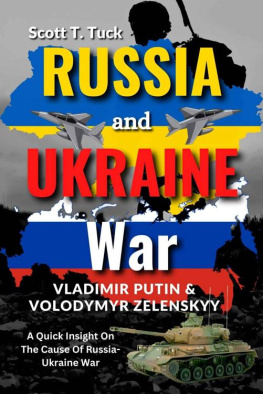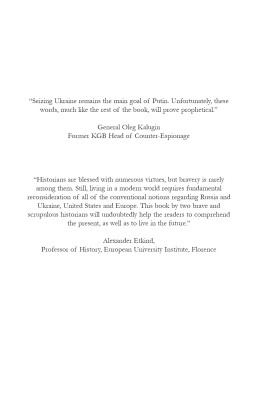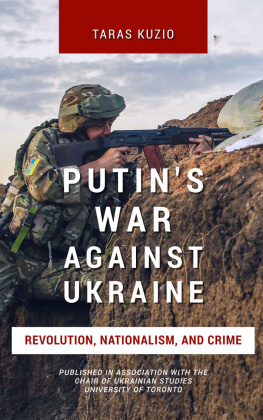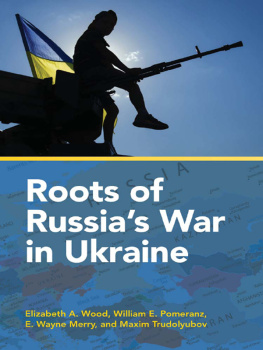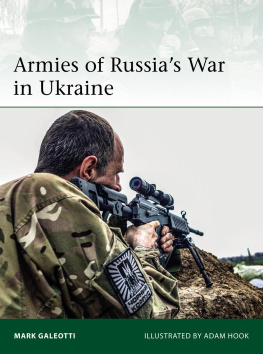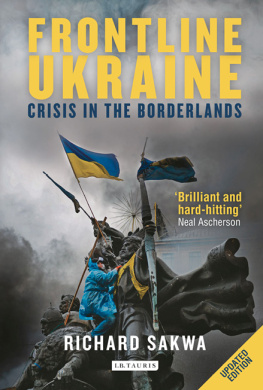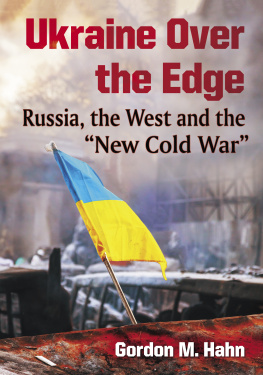Ukraine and the Art of Strategy

Oxford University Press is a department of the University of Oxford. It furthers the Universitys objective of excellence in research, scholarship, and education by publishing worldwide. Oxford is a registered trade mark of Oxford University Press in the UK and certain other countries.
Published in the United States of America by Oxford University Press
198 Madison Avenue, New York, NY 10016, United States of America.
Oxford University Press 2019
All rights reserved. No part of this publication may be reproduced, stored in a retrieval system, or transmitted, in any form or by any means, without the prior permission in writing of Oxford University Press, or as expressly permitted by law, by license, or under terms agreed with the appropriate reproduction rights organization. Inquiries concerning reproduction outside the scope of the above should be sent to the Rights Department, Oxford University Press, at the address above.
You must not circulate this work in any other form and you must impose this same condition on any acquirer.
Library of Congress Cataloging-in-Publication Data
Names: Freedman, Lawrence, author.
Title: Ukraine and the art of strategy / Lawrence Freedman.
Description: New York, NY : Oxford University Press, [2019]
Identifiers: LCCN 2018020914| ISBN 9780190902889 (hardcover) |
ISBN 9780190902896 (updf) | ISBN 9780190902902 (epub)
Subjects: LCSH: UkraineStrategic aspects. | Ukraine Conflict, 2014 |
Russia (Federation)Military policy. | UkraineForeign relations
Russia (Federation) | Russia (Federation)Foreign relationsUkraine.
Classification: LCC UA829.U4 F74 2019 | DDC 947.7086dc23
LC record available at https://lccn.loc.gov/2018020914
Table of Contents
This work began with a graduate seminar organized by Christine Cheng and was helped on its way by feedback from Christine and Tim Sweijs. Ryan Evans provided me with the opportunity to try out my developing thoughts on the Ukrainian conflict on his excellent site, War on the Rocks, and then Dana Allin and Matthew Harries encouraged me to turn them into pieces for the journal Survival. This series of articles benefitted from comments by Ian Kearns and Theo Farrell, while Nicholas Marsh of the Peace Research Institute Oslo (PRIO) kept me and others well supplied with up-to-date material on the conflict in Ukraine. Anne Applebaum and Alexander Clarkson offered helpful comments on the book manuscript. It has been a pleasure to work again with my editor David McBride and his excellent team at OUP.
Ukraine and the Art of Strategy

Map 1
You Cant Always Get What You Want
ROLLING STONES, Let It Bleed, 1969
On March 18, 2014, President Vladimir Putin of Russia announced that Crimea, which had been part of Ukraine, was now part of Russia. This was territory seized by Russian Special Forces acting with local separatists at the end of February. Soon a similar combination of forces was at work in Eastern Ukraine. While these efforts did not lead to further annexations, separatist enclaves were established with Russian support in the Donbas region.
The action was taken because Russia faced an abrupt loss of influence in Ukraine following a successful uprising against President Viktor Yanukovych. The trigger was clear enough. Less clear were Putins objectives. One view was that Moscow hoped to foster a broad-based movement opposed to those taking power in the capital, Kiev. Perhaps such a movement could put irresistible pressure on the new Ukrainian government to back away from its pro-Western course. Alternatively, the hope might have been that parts of Ukraine, particularly the old territory of Novorossiya, might then attach themselves in some way to Russia. Whatever the original aspiration, by the spring of 2014 Russian efforts were concentrated in the two Donbas enclaves of Donetsk and Luhansk (Donbas refers to the Donetsk Coal Basin). A Ukrainian Anti-Terrorist Operation looked like it might take back the lost territory, prompting a more overt Russian intervention using regular forces, which reinforced and consolidated the separatist enclaves. A cease-fire was agreed on in Minsk in September 2014, which also outlined the basis of an eventual peace settlement. The enclaves, but not Crimea, would revert to Ukraine. In return, the region would have more autonomy. This approach was confirmed in February 2015, also at Minsk, but was not implemented. Instead, there was a stalemate, with regular fighting and casualties. The boundaries of the enclaves moved but not by much.
When the conflict first broke, there were concerns that this could be the start of something much bigger. NATO countries challenged the annexation, and Russia was condemned at the UN Security Council (although its veto ensured that it was not censured in a resolution). Moscow responded with threats to other neighboring states and made references to its nuclear strength, raising the political temperature across Europe and causing NATO to look to its own preparedness for war and the need to shore up deterrence. Countries such as Estonia stressed their vulnerability to Russian aggression. Neutral states such as Sweden and Finland began to consider whether they should join NATO. Scares about a wider military conflict eventually subsided, but the measures and countermeasures continued to have deep and significant effects. Western sanctions combined with a fall in the oil price hurt Russias economic performance. Russias attempts to sow divisions and encourage the rise of parties in the West more sympathetic to its concerns became a major issue, especially when US intelligence agencies reported on the ways in which Russia had attempted to influence the outcome of the 2016 presidential election.
This conflict was a product of the postCold War order. Prior to the end of 1991, when the Soviet Union split into fifteen independent republics, any action ordered by Moscow to get Ukraine into line would have been considered the Soviet Unions own business. Western states would have commented adversely but without any basis on which to get involved. For example, as late as January 1991 the Soviet leadership used force to restrain Lithuanian demands for independence with only muffled Western criticism. Yet by the end of that year the Soviet Union was no more, and Lithuania became an independent country. In 2004 it joined NATO, gaining the protections of alliance and also became part of the EU. Ukraine, once it became a sovereign, independent state, could in principle follow the same path and join whatever alliances and economic organizations it chose. But Russia was never at ease with the idea of an independent Ukraine. Instead it sought to draw it back into a closer relationship. The 2014 crisis erupted when this effort failed. What would once have been an internal matter for the Soviet Union was now a matter of international concern.
Just before this crisis came to a head, I published a book on the history of the concept of strategy and how it had come to be applied in a number of settings.with the outcomes that might have been anticipated by looking at the balance of power at their start (hence it was about creating power). As the Ukraine crisis broke and became more severe, this case appeared relevant to my approach to strategy as practice. Not only were the affected countries entering uncharted territory, requiring a substantial degree of improvisation, but also the comparative strategic performance by the key actors was being evaluated. There was more at stake with the Russo-Ukraine conflict than just the future of those two countries. NATO was not directly engaged in the fighting, but it had to consider whether and how it might seek to influence events and prepare for future escalation.

